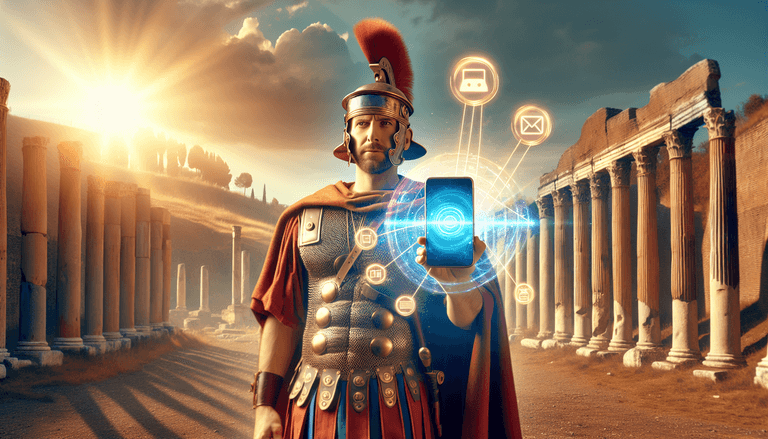Ah, the Roman Empire. When you think of it, perhaps images of grandiose marble structures, heroic legions marching in perfect unison, or emperors ruling with an iron fist come to mind. But what if, and here's a real brain-tingler, the Romans had smartphones? Frankly, it's enough to make one thumb-scroll through the annals of time and chuckle at the possibilities.
Texts and Tactics
Imagine, if you will, Caesar standing in the Forum, poised not with the notorious "Veni, vidi, vici," but rather tapping hastily on his smartphone. This digital doodad would transform communication across the Empire, trumping even the most efficient of heralds.
"Amici, breakfast selfies from Britannia warming your insula? #ConqueringLife" Caesar might post casually on Instanum (the Roman equivalent of Instagram), sharing a sun-soaked portrait of himself amidst newly built forts and vanquished foes.
Military strategists would exchange encrypted messages via Roman Messenger. "Legio IX dispatched to Caledonia. ETA: 2-3 days #MarchForth," might ping across the Appia Via instead of via parchment. A simple snap of a Roman boundary stone could instantly alert officials to the latest Dacian débâcles on the borders.
Hashtag Hilarity and Hooting Hordes
The hashtag would no doubt stand alongside shield and sword as a weapon of cunning measure. Emperors vying for allegiance might well find Twitterae their battleground of choice, armed with biting salvos of 280-character rhetoric.
Nero might tweet, "Being Emperor's lit tonight, literally #ThisIsFineRome," as he might have documented his controversial moments mentioned by the historians as fiddling while Rome burned.
This virtual proscenium would give rise to influencers. Consider a vlogger named Maximus: "Watch how I transform the humble tavern drink into ambrosia! #MaximusMouthfuls." Throngs of toga-clad enthusiasts might clamour for a sip of the golden nectar, subscribing enthusiastically to his YouTubeus channel.
Apps for Empire-Building
Think about the Roman Senate convening not in solemn gatherings but through conference call apps. "Join our Senate chat this Saturn's Day for a vital discussion on expanding the aqueduct network," would be an invite sent via Attendrix (their unparalleled event organiser app). Key decisions would be made sitting comfortably in one's lectus.
Architects would deck out Colossus of internets with virtual reality tours of villas on Zillowium. Buyers could survey properties without venturing into unexplored provinces, projecting holographic designs to patrons.
Shopping would become a new sensation with Amazonica offering everything from spaths and chariots to finest Roman fashion delivered straight to your villa door, complete with parchment receipts e-mailed to your personal inbox.
Wi-Fi at War
Now, perhaps the most profound implications might surface on the battlefield. In a world where Wi-Fi wafted through the air as free and abundant as pigeons in Trajan's Market, generals could deploy drone-augmented combat strategies.
Handheld devices sending real-time updates would revolutionise coordination of legions, allowing for precise maneuvers. Imagine a general barking into his Bluetoothus: "Right flank regroup! Left flank, initiate Pinserius Movement."
And instead of tablets, commanders would pore over Gaius Maps to view territory topography, traffic updates, and which roads were best for the laden baggage train. "Taking the old Appian bypass, traffic on Flaminian congested, avoid like a plebeian riot!" might read a notification.
Tech Triumphs: Rome’s Lasting Legacy
All in all, smartphone technology could have acted as a catalyst for evolution, igniting the Roman Empire to unconsidered heights of efficiency, hilarity, and infamy. Oh, how Western civilisation might have altered under the blue metallic glow of devices, nestled beneath the shade of laurels on pensive brows.
Perhaps if the Roman Empire had smartphones, the legend of its rise and fall might yet linger a little longer in mankind's hymnbook.







